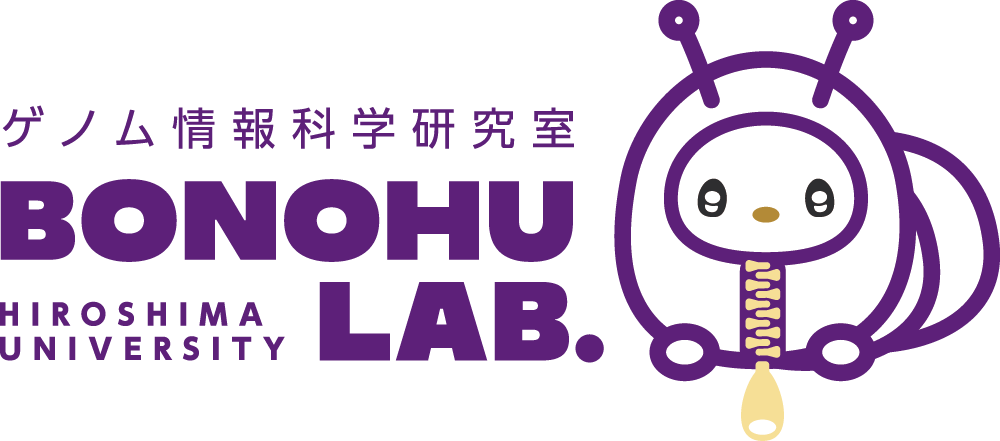Hidemasa Bono
Dr. Hidemasa Bono is a professor of genome informatics science in Hiroshima University. He is in charge of developing basic technologies for genome editing data analysis and gene function analysis by bioinformatics. He is working on data-driven approaches, especially data analysis using public databases, and is conducting research on digital breeding by metabolic pathway design using BioDX.
Please refer Profiles of Faculty and Research Scholars for my activities provided in Hiroshima Univesity website.
Research activities
Research projects involved so far
- Transcriptome (Microarray, RNA Sequencing)
- Systematic functional annotation (formerly prediction) of genes
- Gene Function Identification Tool (GFIT) (1996-2000)
- Functional annotation of mouse (FANTOM) (2000-2003)
- Kaiko annotation pipeline (2010-2020) -> Fanflow (2020-)
- Meta-analysis of stressed transcriptomes (2007-)
- Systematic functional annotation (formerly prediction) of genes
- Genome (sensu stricto)
- Short sequence pattern search in the genome
- SayaMatcher (2003-2007)
- GGRNA, GGGenome (2011-2020) -> CRISPRdirect (2015-2020)
- Genome editing target region search (2020-)
- Short sequence pattern search in the genome
- Bibliome
- Application of natural language processing method for life science
- Allie (2007-2011)
- Gendoo (2007-2020)
- Multi-omics analysis with the bibliome (2021-)
- Application of natural language processing method for life science
- Reference datasets for re-use
- Reference Expression dataset (RefEx) (2010-2020)
- DBCLS SRA (2011-2020)
- All of gene expression (AOE) (2014-)
- Genome editing meta-database (GEM) (2022-)
Time-course description about the projects
Hiroshima University (2020-)
- Genome analysis of non-model organisms for genome editing
- Utility of public databases in life science
- Functional annotation workflow (Fanflow)
- Meta-analysis of stressed transcriptomes
- Hypoxic stress (human, mouse, plants)
- Oxidative stress (human, mouse, insects)
- Crowd stress (insects)
- Heat stress (human, mouse)
- Multiple stress in plant
Database Center for Life Science (DBCLS) (2007-2020)
- Functional annotation of public transcriptome data
- RefEx: reference expression dataset for functional analysis of genes of interest
- AOE (All of Expression): index of public gene expression data
- Collaboration with DDBJ Genomic Expression Archive (GEA)
- Systematic analysis of transcriptomic sequences
- KAIKO functional annotation pipeline -> unannotated insects
- RNA-seq Workflow for insects making use of Transcriptome Shotgun Assembly (TSA) database
- Constructing and maintaining educational materials for Japanese
- TogoTV: Tutorial movies for databases and web tools for life science (mostly in Japanese)
- AJACS: Off-line tutorial series in database and web tools
- MotDB: Tutorial website for life science (Japanese only)
Saitama Medical University, Research Center for Genomic Medicine (RCGM) (2003-2007)
- Deciphering hypoxic signaling networks in eukaryotes fully utilizing genomic resources
- Comparative genomic approach for identifying conserved core networks
- C.elegans and mammalian cells
- Computational research environment for integrated analysis of genomic data
- SayaMatcher: genome scale organization and systematic analysis of nuclear receptor response elements. Bono HU (2005)
- Pathway analysis of cancer cells
- The study of metabolic pathways in tumors based on the transcriptome. Bono H and Okazaki Y (2005)
- Collaborations
- Genome Network project
- Finding nuclear receptor response elements in mammalian genomes
- Peroxisome Proliferator Activated Receptors (PPAR)
- Andorogen Receptor (AR)
- Identification and functional analysis of consensus androgen response elements in human prostate cancer cells
- Identification of novel steroid target genes through the combination of bioinformatics and functional analysis of hormone response elements
RIKEN Genomic Sciences Center (GSC) (2000-2003)
- Transcriptome analysis of RIKEN cDNA microarrays
- 20k vs mouse 49 tissues
- 60k vs mouse 20 tissues
- Functional annotation of mouse (FANTOM)
Kyoto University, Institute for Chemical Research (KUICR) (1995-2000)
- Analysis of amino acid synthesis pathway in the complete genomes utilizing KEGG
- Analysis of bacterial two-component (His-Asp phosphorelay) signaling pathway in the complete genome sequences
The University of Tokyo (1994-1995)
- Cloning one subtype of gamma subunit of hetero trimeric G-protein (as an undergraduate student)

Social